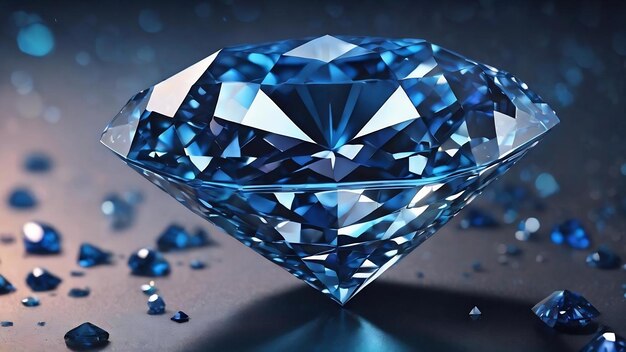Inclusions in lab grown diamonds are often a subject of curiosity for many buyers and enthusiasts of fine jewelry. While these diamonds are created in a controlled environment, just like natural diamonds, they still contain certain imperfections known as inclusions. Understanding these inclusions is essential when considering a lab grown diamond for an engagement ring, pendant, or other jewelry pieces. This article will explore what inclusions are, how they affect the value of lab grown diamonds, and why they are an important consideration when purchasing a diamond.
What Are Inclusions in Lab Grown Diamonds?
Inclusions in lab grown diamonds are internal imperfections that occur during the diamond’s formation process. These inclusions are similar to those found in natural diamonds, and they can range from small bubbles of gas or trapped minerals to more noticeable flaws, such as cracks or clouds within the diamond. Although lab grown diamonds are created in a controlled environment, the process mimics the natural conditions under which diamonds are formed, and thus inclusions can still develop.
The presence of inclusions in lab grown diamonds is important to understand because these imperfections affect the overall appearance and quality of the diamond. However, it’s essential to note that most inclusions are microscopic and can only be detected under magnification by a trained gemologist. Many buyers choose to prioritize other factors, such as color and cut, over inclusions when selecting their ideal diamond.
The Types of Inclusions Found in Lab Grown Diamonds
Inclusions in lab grown diamonds come in various forms, each with its own unique characteristics. Some of the most common types of inclusions found in lab grown diamonds include crystals, feathers, clouds, and needles. Crystals are small mineral deposits trapped inside the diamond as it forms, while feathers are thin, hairline fractures that can develop during the diamond’s growth process. Clouds consist of small groups of inclusions that can affect the clarity of the diamond, and needles are long, thin inclusions that resemble small, needle-like structures.
Each of these inclusions can vary in size, shape, and visibility. Some are so small that they do not affect the diamond’s overall appearance, while others may be more noticeable. The type, size, and location of the inclusions play a key role in determining the clarity grade of the lab grown diamond. A higher clarity grade generally indicates fewer and less noticeable inclusions, which can increase the diamond’s value and desirability.
How Inclusions Impact the Value of Lab Grown Diamonds
Inclusions in lab grown diamonds can have a direct impact on the diamond’s value. Generally, the fewer the inclusions, the higher the clarity grade, and the more valuable the diamond becomes. Diamonds with high clarity grades, such as flawless or internally flawless diamonds, typically fetch higher prices because they are rare and have fewer visible imperfections. On the other hand, diamonds with more noticeable inclusions may have a lower clarity grade and, as a result, a lower price.
While inclusions can affect the value, it’s important to note that not all inclusions are detrimental to a diamond’s appeal. Many buyers are willing to accept minor inclusions if they can save money on a diamond that still possesses excellent color and cut. In fact, some inclusions are so small and inconspicuous that they do not impact the overall appearance of the diamond, making them an acceptable feature for many buyers who prioritize affordability over perfection.
Identifying Inclusions in Lab Grown Diamonds
Identifying inclusions in lab grown diamonds requires careful examination, typically using magnification tools such as a jeweler’s loupe or a microscope. Most inclusions in lab grown diamonds are microscopic and can only be seen under magnification. Professional gemologists can examine the diamond’s clarity and identify the type, size, and location of inclusions, providing a clarity grade based on these factors.
When purchasing a lab grown diamond, it’s important to look at a detailed certificate, such as a grading report from a reputable gemological lab. These certificates provide valuable information about the diamond’s clarity, including a description of any inclusions and their impact on the diamond’s overall quality. Understanding this report can help buyers make informed decisions and select a diamond with the right balance of clarity and value.
Are Inclusions in Lab Grown Diamonds Noticeable?
One of the most common concerns about inclusions in lab grown diamonds is whether they are visible to the naked eye. In most cases, inclusions are microscopic and can only be detected under magnification. For diamonds with high clarity grades, such as VS (very slightly included) or better, the inclusions are so small that they are invisible to the naked eye. Even diamonds with inclusions that are visible under magnification are often still beautiful and possess remarkable brilliance.
Inclusions in lab grown diamonds are usually not noticeable when the diamond is set in jewelry, especially if the inclusions are small or located in areas that are not easily visible. The brilliance and sparkle of the diamond, which come from its cut and overall quality, can often mask the visibility of inclusions. As a result, many buyers choose to prioritize other factors, such as the diamond’s cut and color, when selecting a lab grown diamond.
The Role of Inclusions in Diamond Grading
Inclusions play a significant role in the grading of lab grown diamonds. The Gemological Institute of America (GIA) and other grading organizations assess diamonds based on the 4Cs: cut, color, clarity, and carat weight. Clarity refers specifically to the presence and visibility of inclusions, with diamonds being assigned clarity grades ranging from flawless (FL) to included (I1, I2, I3).
Inclusions in lab grown diamonds are evaluated according to their size, type, number, and location within the stone. Diamonds with fewer or less noticeable inclusions receive higher clarity grades, while diamonds with more visible inclusions may be assigned lower grades. Understanding the clarity grade of a lab grown diamond can help buyers make an informed decision based on their preferences for appearance and value.
Embracing Inclusions in Lab Grown Diamonds
Inclusions in lab grown diamonds do not have to be viewed as flaws or imperfections. In fact, they can add uniqueness and character to a diamond, making each one distinct. Some buyers may even find charm in the fact that their diamond has a story to tell through its inclusions. Inclusions are also a great way to distinguish between a natural diamond and a lab grown one, as both types of diamonds may have similar inclusions but with different origins.
For many buyers, choosing a lab grown diamond with slight inclusions is a practical decision. The affordability of diamonds with minor inclusions, combined with the ethical and sustainable benefits of lab grown diamonds, makes them an attractive option for those who want a beautiful, high-quality diamond at a more accessible price point. Embracing inclusions in lab grown diamonds allows buyers to enjoy the beauty of a unique gemstone while making an investment that aligns with their values.
Conclusion: Understanding Inclusions in Lab Grown Diamonds
Inclusions in lab grown diamonds are an important factor to consider when purchasing a diamond. While these inclusions can affect the diamond’s clarity and value, they do not necessarily diminish the overall beauty and appeal of the stone. By understanding the types of inclusions, their impact on the diamond’s value, and how to identify them, buyers can make more informed decisions when choosing a lab grown diamond. Whether you prioritize clarity or budget, there is a lab grown diamond to suit every preference, and inclusions can often be a minor consideration in comparison to the many other factors that contribute to the diamond’s overall beauty.

